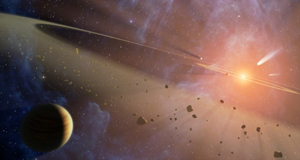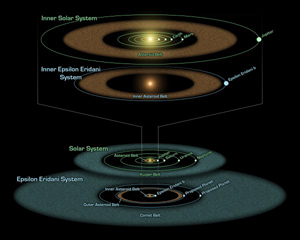Our Solar System contains a vast belt of rocky asteroids sitting in an orbit roughly between the planets Mars and Jupiter, but astronomers have found a reason for us to be envious of other star systems. They have discovered that a single belt is not the only possible arrangement of the primordial debris that remains following planet formation around a star.
Dana Backman of the SETI Institute and colleagues have found that the nearby star Epsilon Eridani has two rocky asteroid belts and an outer icy ring, making it a triple-ring system. The inner asteroid belt is a virtual twin of the belt in our solar system, while the outer asteroid belt is much more massive, holding twenty times as much material. The astronomers explain that the existence of these three rings of material suggests that undiscovered planets in the Epsilon Eridani system confine and shape the rings.

Massimo Marengo
Epsilon Eridani is a smaller, younger, cooler star than the Sun, nestling in the southern constellation of Eridanus, the river, about 10.5 light-years from Earth. It is a mere 850 million years old and astronomers consider the Epsilon Eridani planetary system to have some remarkable similarities with our solar system at a comparable age. Studying Epsilon Eridani is like having a time machine to look at our solar system when it was young, according to team member Massimo Marengo of the Harvard-Smithsonian Center for Astrophysics. Backman agree pointing out that, This system probably looks a lot like ours did when life first took root on Earth.
Using NASA’s Spitzer Space Telescope, the team identified an asteroid belt orbiting Epsilon Eridani at an equivalent distance as our own asteroid belt – 3 astronomical units. However, they also spotted a second asteroid belt at 20 astronomical units from Epsilon Eridani, the approximate distance Uranus is located in our solar system. The total mass of this second asteroid belt is about the same as Earth’s Moon.

Dr Dana Backman
The third, ring of icy material sits at about 35 to 100 astronomical units from Epsilon Eridani and is the equivalent of the Kuiper Belt in our solar system, but this previously discovered third ring has a mass one hundred times that of the Kuiper Belt.

Some star systems are more equal than others (Credit: NASA/JPL-Caltech)
Theorists have suggested that when our Sun was 850 million years old, the Kuiper Belt would have resembled more that seen in Epsilon Eridani, but in the intervening billions of years, much of its material has been swept away, hurled out of the solar system, or plunged into the inner planetary region in the Late Heavy Bombardment. The enormous craters on our Moon are evidence of this bombardment.

Running rings around a star system (Credit: NASA/JPL-Caltech)
It is possible that Epsilon Eridani will undergo a similar dramatic clearing in the future, the astronomers say. Epsilon Eridani looks a lot like the young solar system, so it’s conceivable that it will evolve similarly, said Marengo. The team points out that the pattern of rings and their total masses suggest that three giant planets with masses between those of Neptune and Jupiter are also orbiting Epsilon Eridani. Further observations will soon reveal more about the character of our distant stellar cousin.
D. Backman, M. Marengo, K. Stapelfeldt, K. Su, D. Wilner, C. D. Dowell, D. Watson, J. Stansberry, G. Rieke, T. Megeath, G. Fazio, M. Werner (2009). Epsilon Eridani’s Planetary Debris Disk: Structure and Dynamics based on Spitzer and CSO Observations Astrophysical Journal
Further reading
Dr Dana Backman homepage
http://www.seti.org/Page.aspx?pid=390
Massimo Marengo homepage
http://www.cfa.harvard.edu/~mmarengo/me/home.html
Suggested searches
asteroids
Kuiper belt